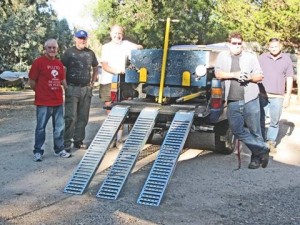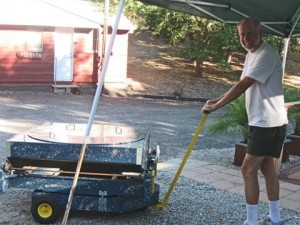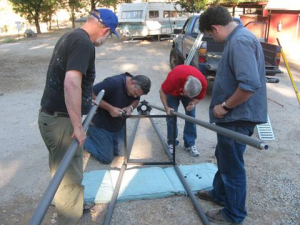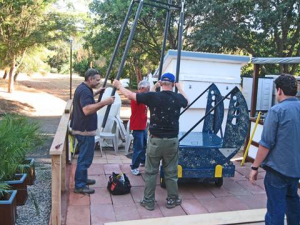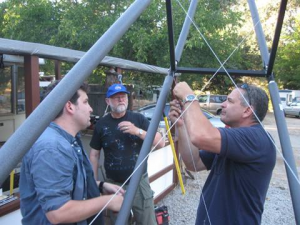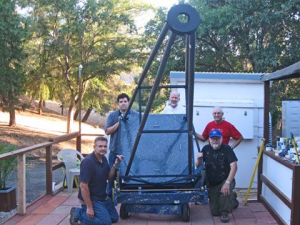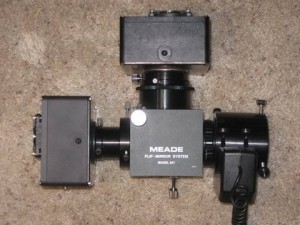After being worked on at Reed and Chris Estrada’s place in Lancaster, California, the 1 meter photometric telescope has been moved back to the Orion Observatory (near Santa Margarita Lake not far from San Luis Obispo, California). Below are some photographs (taken by Cheryl Genet) of the telescope being set up.
IMPORTANT: Click on the image to enlarge!
“Big Blue” arrives from Lancaster in the back of Reeds pick up truck. Left to right: John Baxter, retired AP Physics teacher Arroyo Grande High School; Tom Frey, Emeritus Prof. of Chemistry, California Polytechnic State University; Russ Genet, Research Scholar in Residence, California Polytechnic State University and Adjunct Professor of Astronomy, Cuesta College; Chris Estrada, Biochemistry major Allan Hancock College and Vice President Central Coast Astronomical Society, and Reed Estrada, Test Pilot, Edwards Air Force Base.
The bright yellow tow bar has been attached to the steerable nose wheel. On the right, one of the two “wheelbarrow” handles has been attached. The other one will be attached to the left side before telescope extraction. The Jeep Cherokee transport vehicle is lower to the ground and the telescope can be rolled out without using the wheelbarrow handles. A hand winch can be used for single senior person extraction or insertion.
Russ hand tows the telescope over loose gravel to its patio parking spot. Per Howard Banich’s advice, the entire telescope, except for the prime focus truss and instruments, stays together as a single unit. One of the two main wheels can be seen lower left. Pneumatic 10 inch tires make travel over rough terrain relatively easy. We initially considered castered front wheels’s shopping cart style but Mel Bartels informed us that without positive steering a heavy telescope on uneven terrain would go where it wanted to go, not where you wanted it to go. Reed and Russ, both pilots, were used to moving tricycle gear aircraft around via a tow bar attached to a steerable nose wheel, so this seemed a natural. At a bit over 300 lbs, this telescope weighs a fraction of what a typical small airplane weighs.
Reed inserts a top truss tube into the square mid-level spacer while Tom holds the last lower truss tube. The original truss assembly used an “X” middle section (similar to the VERITAS Cherenkov radiation and Fairborn Observatory telescopes). However this approach lacked rotational stiffness (without the addition of outriggers, a significant complication).
At RTMC, Dave Rowe suggested we switch to a square middle section approach. This approach is similar to that used by the HESS Cherenkov radiation telescopes. We also switched from square to round tubing allowing one more degree of freedom during assembly.
The assembled lightweight truss, which can be easily lifted by two persons, is lifted into place. The Orion Observatory’s 10 inch SCT is housed in the flip top structure behind Big Blue. Russ; front porch shop is on the right.
Reed hooks one of the X guy wires to the square mid section. While pointing at the Zenith, all connections are loosened and the telescope is given the “Kent Wallace shake” so everything drops into place. The turnbuckles on the guy wires and connections are then firmly tightened.
The crew poses with the assembled telescope. The goal is to refine the assembly procedure so that two persons can unload, assemble, and collimate the telescope in a half hour or less, thus meeting the Banich Bylaw definition of portability.
Several prime focus instrument packages are planned. All use the Meade micro-focuser (on the right). This package utilizes a Meade flip mirror system where the mirror has been replaces with a dichroic filter. This allows simultaneous two color (V and I) photometry. Alternatively, the dichroic filter can be flipped out of the way and the single straight through camera used for sequential multicolor photometry.
Other prime focus instrument packages planned include those for high speed (millisecond) photometry and near infrared photometry.
Follow Us:
